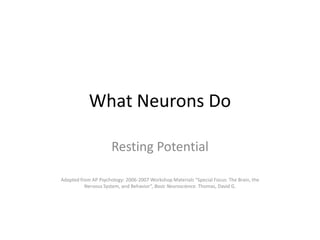
What neurons do, resting potential
- 1. What Neurons Do Resting Potential Adapted from AP Psychology: 2006-2007 Workshop Materials “Special Focus: The Brain, the Nervous System, and Behavior”, Basic Neuroscience. Thomas, David G.
- 2. Neuron function The function of a neuron is to take in information from the environment or from other neurons, integrate that information, and then send information along to other neurons.
- 3. Let’s explicate! Environmental input – We’ll leave out external stimuli for now and focus on neuron-to-neuron transmission. Information – Substitute “chemical messengers” Dopamine Seratonin GABA Integrate – To add together, for example, both the excitatory and inhibitory chemical messages.
- 4. Revised definition The function of a neuron is to take in the chemical messages that other neurons send it, add together the excitatory and inhibitory messages they carry, and pass on chemical messengers to other neurons if the excitation is great enough.
- 5. How it works Recall 5th grade math. Positive and negative numbers… Say you are the treasurer of an organization, and to aid your bookkeeping you keep a cash box. In that box are two types of paper slips. Some represent debits and are thus negative numbers; others represent deposits and are positive numbers. Figure 1 shows the contents of your treasury box with a net value of –5 dollars. A potential donor has said that, if your club can reach a net value of +5 dollars, she will provide a gift of $1,000. Therefore, adding a deposit slip of +2 dollars nudges you toward that threshold value of +5, while adding a debit slip of –1 or subtracting a deposit slip of +1 pushes you away from the threshold. Figure 1: Treasury Box Analogy This and the other images in this article were created by the author, David G. Thomas.
- 6. Resting Potential Now let us map our treasury box onto neural function. The box represents a neuron that is a living cell. The debit slips represent molecules within the neuron that carry a negative electrical charge. In real neurons, these negatively charged ions are mostly large protein molecules that cannot move out of the neuron. We will use the symbol –P to refer to these. The deposit slips represent positively charged ions, which can be either potassium or sodium. Potassium ions (which we will abbreviate as +K) are concentrated inside of neurons; sodium ions (+Na) are concentrated outside of neurons. Also concentrated outside are negatively charged chloride ions (–Cl). Although the –P ions always stay inside the neuron, the other three ions can pass through the wall, or membrane, of the cell. Analogous to the treasury box, adding and subtracting these ions will influence the net value, or potential, within the cell. And, as with the treasury box, if that potential becomes positive enough and the threshold value is met, a major event occurs.
- 7. Resting Potential The delicate balance of these four ions creates what is called the resting potential inside the neuron. This means that when no information (no excitatory or inhibitory chemical messenger) is picked up by the neuron, the four ions are in equilibrium. -P = negatively charge Proteins inside the neuron. Cannot pass through the cell membrane. +K = Potassium ions. Concentrated inside the neuron, can pass through membrane. +Na = Sodium ions. Concentrated outside the neuron, can pass through membrane. -Cl = Chloride ions Concentrated outside neuron, can pass through membrane.
- 8. Resting Potential We should call this a dynamic equilibrium because three major forces are at work here that produce the delicate balance. The first force is called electrostatic pressure and can best be described as “opposites attract,” meaning that areas of negative charge, like the –70 mV charge inside the neuron, attract positively charged ions like +Na. Conversely, charges that are alike repel each other. The –70 mV resting potential within the neuron repels the negatively charged chloride ions (–Cl). The second force of this dynamic equilibrium is the tendency for molecules to move from areas of high concentration to areas of lower concentration. Therefore, since –Cl ions are concentrated outside of the neuron, they will tend to move into the cell where there are few –Cl ions.
- 10. Notice now +Na. We can see that both forces are acting on +Na ions to push them into the neuron. Why, then, is our –70 mV electrical potential not quickly drained in a manner similar to what would occur if the two terminals of a car battery were connected by a wire?
- 11. The answer is that the permeability of the membrane at rest is very low for Na+ ions, while it is relatively high for +K (and –Cl). Figure 2: The Four Ions That Determine the Resting Potential